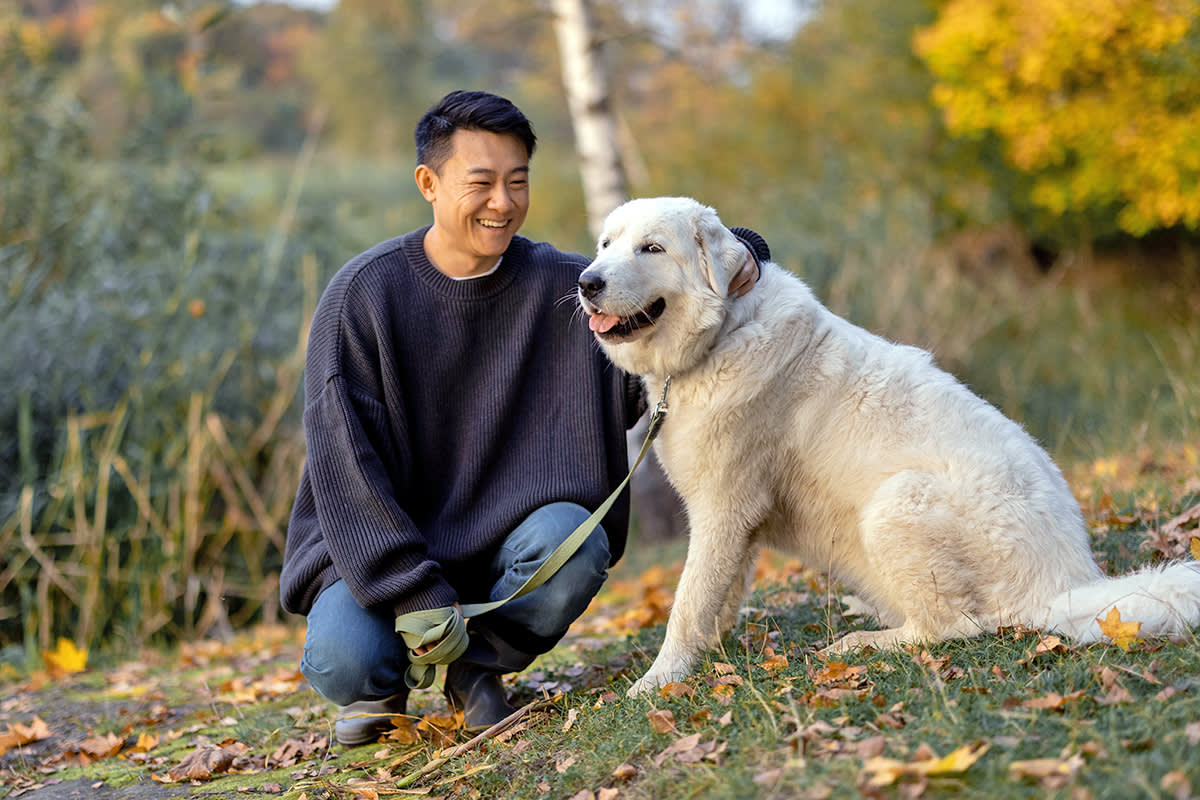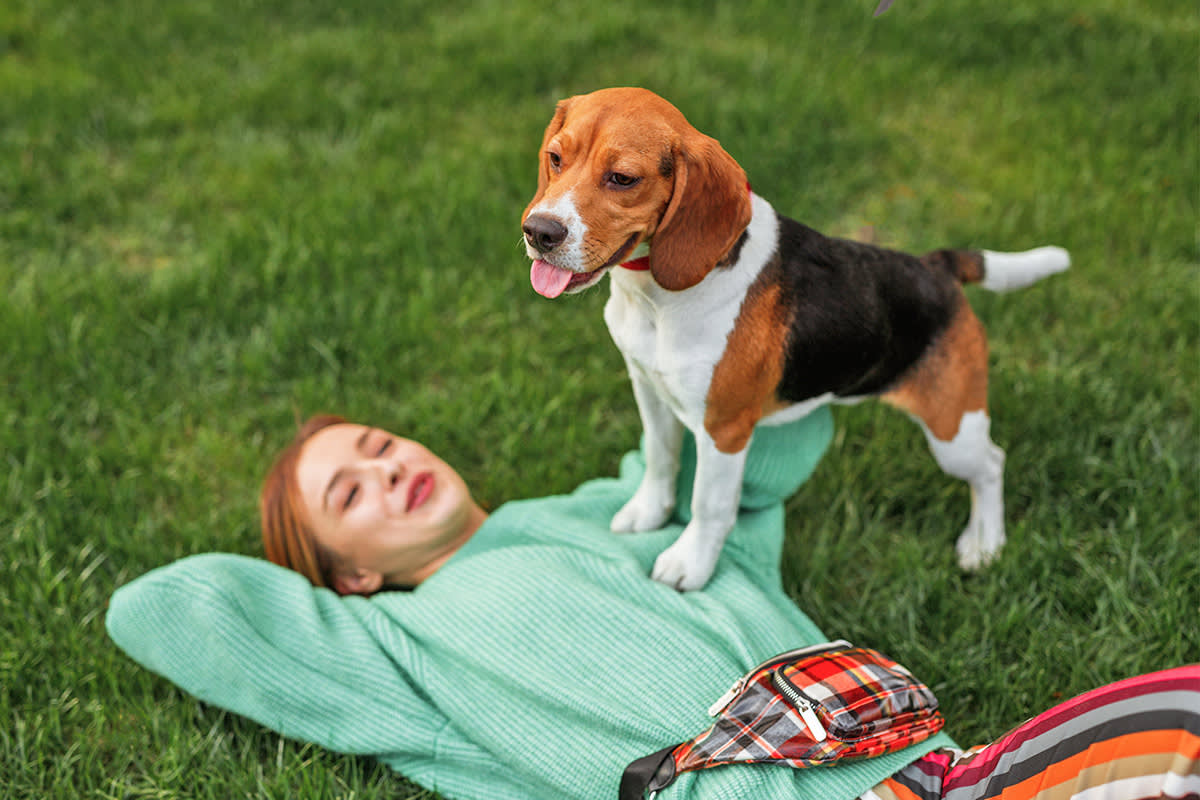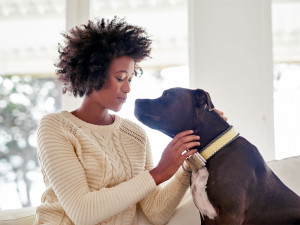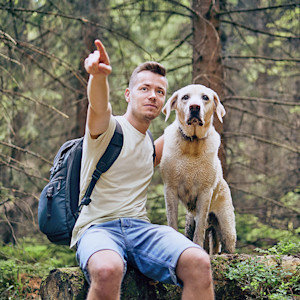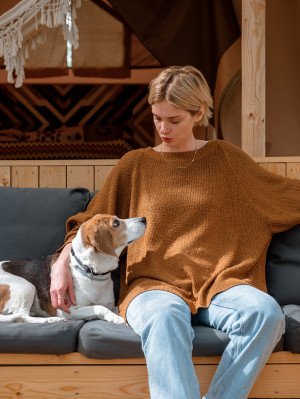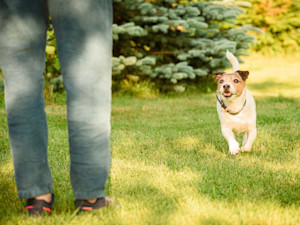Why Dogs Avoid Eye Contact and Other ‘Appeasement Behaviors’ to Look Out For
It’s more than just a weird little habit.
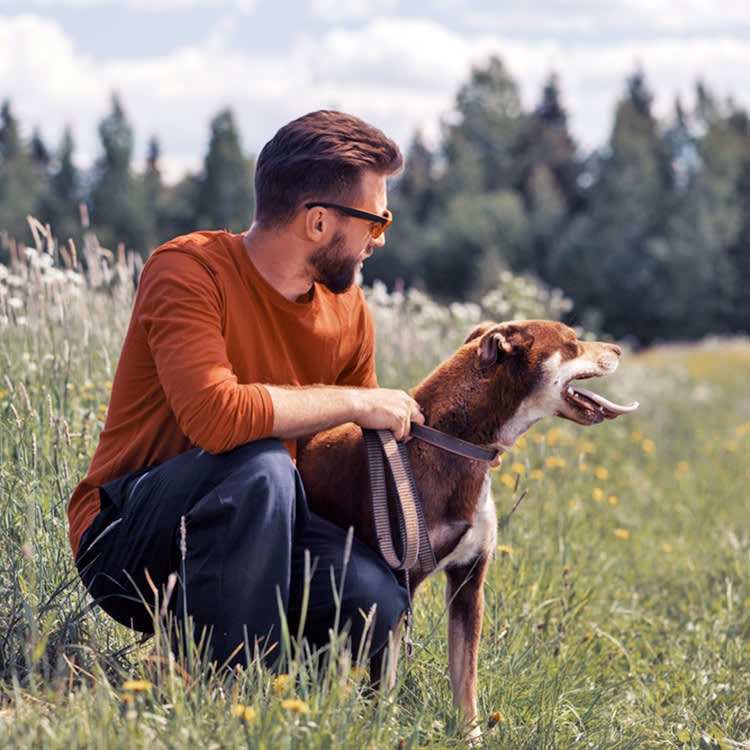
Share Article
It’s an adorable kind of paradox: Dogs have the cutest eyes in the world, so why do they seem so... uncomfortable when we get lost in them?
Eye contact might be polite in human society, but for dogs, it’s a different story. According to Laurie Lawless, a certified dog behavior consultant and owner of Shelter Behavior Integrationsopens in new tab, our pups often perceive direct eye contact as confrontational. When our pups avoid our eyes or turn their heads away, they’re not being rude — they’re trying to tell us that they feel uncomfortable and that they’re not a threat.
“Dogs often avert eye contact when they want to communicate that are wanting to avoid conflict,” Lawless says, and also “to deescalate perceived tension.”
Still, we shouldn’t immediately assume that dogs who occasionally avert their eyes don’t feel comfortable with us in general. Both Lawless and certified dog behavior consultant and accredited dog trainer Emily Scott explain that often, these interactions can be situational — meaning, there could be a ton of reasons your dog is feeling stressed.

Why does my dog avoid eye contact?
Avoiding eye contact is what’s known as an “appeasement behavior”— body language dogs use to de-escalate conflict. According to Lawless, these maneuvers are basically doggie code for “Hey, I’m not looking for a fight today.”
If a dog is scared or worried about the outcome of a particular interaction, they might use appeasement as a way to smooth things over. According to Scott, avoiding eye contact can also be a precursor stress signal that our pups use to create more distance between themselves and humans, dogs, and other creatures.
“Precursor signals are body language that is basically saying that [our dogs] are stressed, or they want distance, or they don't want you to think that they’re a threat,” Scott says.
In other words, consider these behaviors your first sign that something is off.
What are other appeasement behaviors?
It’s not just the eye thing. As it turns out, a lot of our dogs’ quirky little habits are actually appeasement behaviors. According to Lawless, these movements can include:
Licking outwards or licking their lips
Stretching
Lifting a paw up and leaning backwards
Shaking their body when dry
Smiling (“yes, it’s cute, but often a sign of stress”)
Lowering their body
Twisting around
Lawless says adds: “You will often see appeasement behaviors surface in dog greetings, and at the groomers, or in other situations in which a socially constructed situation needs to be navigated.”
Another reason some pups sometimes try and appease? When they’ve done something “bad.”
Although our dogs do not feel guilt or embarrassment,opens in new tab Lawless says, they do anticipate conflict when a frustrated human approaches. In those cases, they might try and offer appeasement to soothe the anger they see on our faces.
Do dogs who feel safe stop using appeasement behaviors?
Pups who are settling into a new environment are more likely to appease than others, Lawless says, as they learn the rules of the house and build relationships with everyone in it.
“You may see these behaviors more frequently at the beginning in certain contexts and situations,” Lawless adds, “such as reaching towards a collar or leashing for walks.”
As your pup begins to settle in, they’ll usually ease up on the appeasement. Still, there’s a good chance you’ll see some of these behaviors from time to time, as they try to express what they want from moment to moment.
“Even if a dog adores you,” Scott says, “they may not always want you in that close proximity for whatever reason. I think we're the same way with our spouses or our kids. It's like, ‘I love you, but leave me alone.’”
Your dog might also display appeasement behaviors that have nothing to do with you — like when they hear a funny noise or encounter a new object in the home that temporarily freaks them out. As long as your dog isn’t using these behaviors all day, every day, they’re probably fine.
How can I put my dog at ease?
Whether you’ve just brought home a new dog or are looking for ways to soothe your current pooch, there are a number of techniques you can use to help them find their inner zen.
Create a chill environment.
A happy dog starts with a happy, predictable home. As obvious as it might seem, Scott recommends keeping your home environment positive and, to whatever degree possible, free of stressors and negative interactions. That will allow your dog to relax.
Then, set up your dog’s routines. Dogs like knowing when they are going to eat and walk during the day. The more you can stick to certain times, the more secure they will feel.
And finally, when interacting with your dog, treat them the way you’d want to be treated. Avoid putting too much pressure on them, handling them when they don’t want contact, or picking them up when they don’t want to be carried. Contrary to some popular advice, Scott adds, you should avoid interacting too dominantly or forcefully with your pup—like by raising your voice or staring them down. Once again, the Golden Rule rules.
Make the house rules clear.
If you’re bringing a new dog into your home, help them adjust by making the no-nos inaccessible. Lawless advises blocking off areas you don’t want the dog to use, hiding garbage, and limiting access to all furniture and items they should not touch. Create a safe space where they can eat and enjoy enrichment treats in peace, without having to worry about guarding their resources.
For the first two weeks, Lawless advises focusing on relationship building over training. “Reward behaviors you like,” she says, like “resting quietly, allowing leashing, using the bathroom outside.” You can start training in earnest once your dog feels safe and comfortable.
Send calming signals.
If your dog tends to appease you, it never hurts to appease them right back. Scott recommends Norwegian dog trainer Turid Rugaas’s book On Talking Terms With Dogs: Calming Signalsopens in new tab, which offers tips for pet parents who want to speak the same language as their dogs. In a similar vein, Lawless recommends neutralizing your own threat level by keeping your voice and body posture relaxed — and by using techniques like turning your body to the side, averting eye contact, talking softly, or even staying silent.
Scott offered a recent example of how this can work: During a recent training session, she noticed that despite her calm and supportive manner, the dog in front of her was not responding well to the pressure. So, she stopped, turned away from the dog, and started to yawn for the dog’s benefit.
“And I yawned a couple more times,” she says. “Sure enough, the dog yawned, and then the dog sat, which is the cue that I was trying to get her to do.”
By showing the dog that she was not a threat, Scott says, she was able to help them relax and do what was needed. That’s what happens when we turn our focus to understanding what they need before anything else.
When should I see a vet?
If you notice your dog’s appeasement behaviors suddenly start to escalate, it’s probably time to consult a veterinarian and possibly a behaviorist. “Dogs may offer more appeasement if they are in pain,” Lawless says, “or if they are finding certain situations repeatedly stressful.”
If, for example, you reach toward your dog, and they pin their ears back and pee on the floor, that could be a sign that your dog feels significant stress during handling. “By nature, appeasement gestures and actions are a signal that a dog wants to avoid perceived hostile interactions, and they can quickly begin to anticipate based on associative learning,” Lawless says. “So, in this example, if leashing is scary, they may start showing appeasement signals the moment you pick up the leash.”
Scott agrees that if your dog throws out stress signals all the time, it’s time to consult the professionals. “It is really important that guardians are aware of these signals,” she says, “because, again, the dog is trying to communicate, and if you’re ignoring communication, then you are at a risk for stressing your dog out.”

Laura Bradley
Laura is a New York-based experienced writer and mom of two rescue pups. Her work has appeared in Slate, Vanity Fair, Daily Beast, The Washington Post, The Atlantic, Yahoo! News, Vulture, Grazia Magazine, and more. When she is not writing or walking the pooches, you will probably find her in the community garden.
Related articles
Why Does My Dog Stare at Me? Possible Reasons and What to Do
Beyond the fact that they’re your biggest admirer.
![Man pointing to something in the distance with his Labrador dog in the woods.]()
New Study Finds the Best Way to Get a Dog’s Attention
It's a combo of two things.
![A woman in a black coat squatting down to speak to her Dalmatian dog who is looking away from her to the camera on a dirt path next to a pond on with fall leaves around]()
Hey, Why Is Your Dog Ignoring You?
Six tips and tricks to get your dog to listen to you.
![Short-haired blonde woman in a tan sweater and blue jeans sitting on a bench talking to her Beagle mix dog who is looking up at her]()
How You Say Something to Your Dog Matters More Than What You Say
TikTok pet parents have made this clear: Tone matters. Celebrity dog trainer Nicole Ellis says dogs can hear “stress in our voice — whether directed at them or when they hear us talking to others.”
![Dog running toward person]()
Do Dogs Actually Recognize Their Names?
Or do they think of it more as a cue that means “come”?
